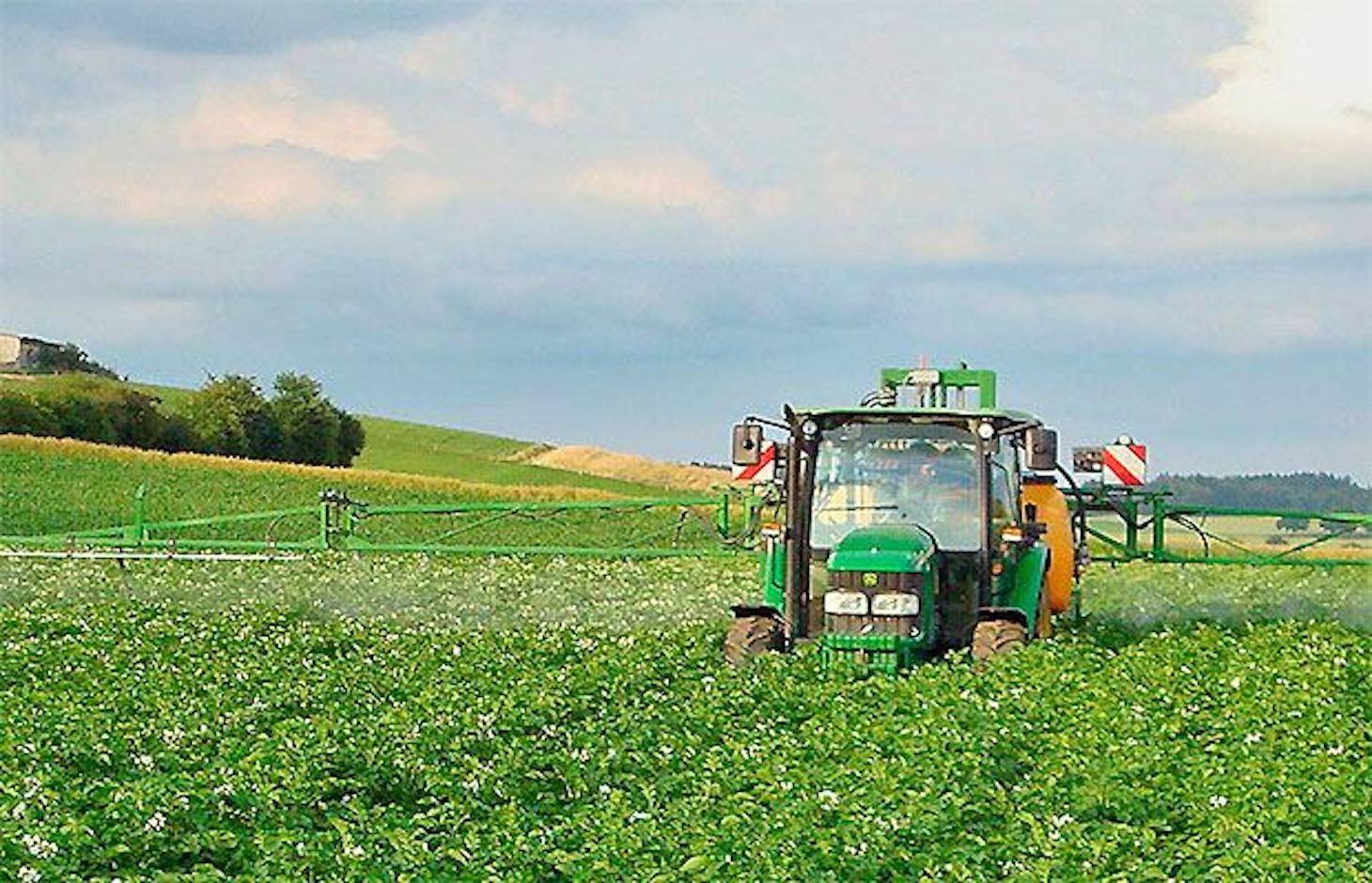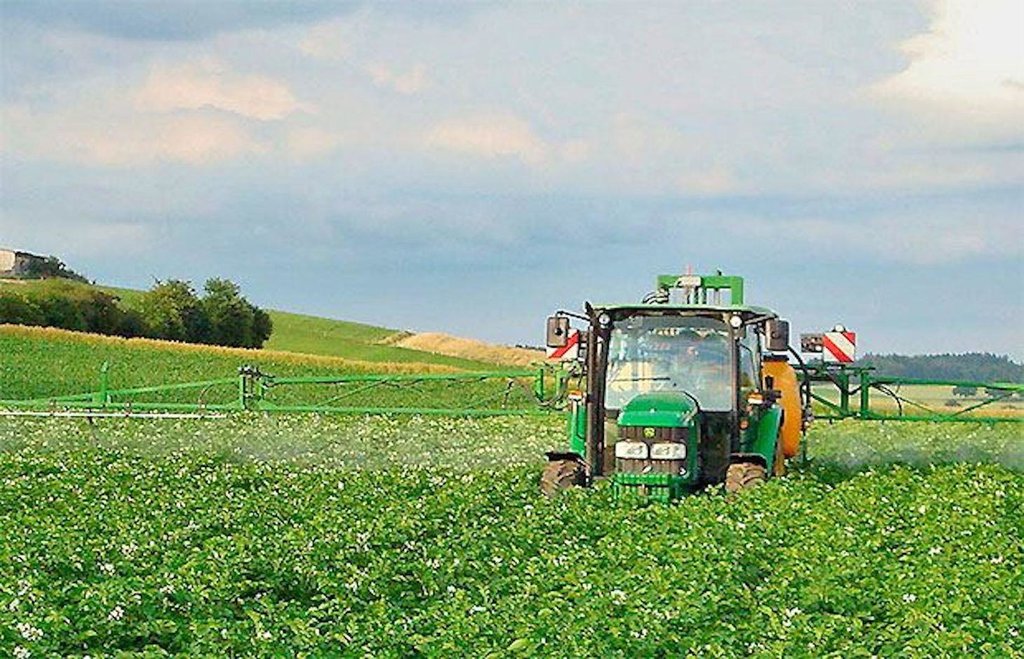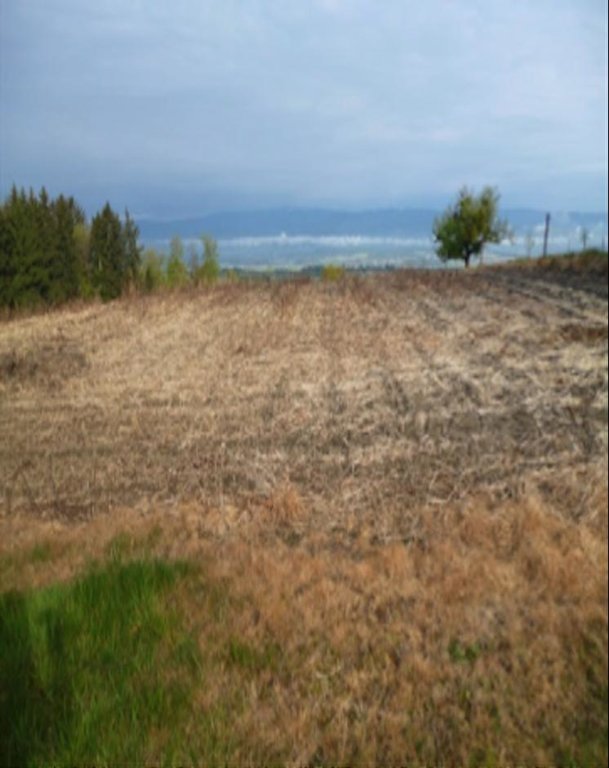Minimization of herbicide application in conservation agriculture [瑞士]
- 创建:
- 更新:
- 编制者: Deborah Niggli
- 编辑者: –
- 审查者: Fabian Ottiger, Alexandra Gavilano
Herbizideinsatz-Minimierung bei Feldern unter Direktsaat
technologies_1259 - 瑞士
查看章节
全部展开 全部收起1. 一般信息
1.2 参与该技术评估和文件编制的资源人员和机构的联系方式
有助于对技术进行记录/评估的项目名称(如相关)
Preventing and Remediating degradation of soils in Europe through Land Care (EU-RECARE )有助于对技术进行记录/评估的机构名称(如相关)
CDE Centre for Development and Environment (CDE Centre for Development and Environment) - 瑞士1.3 关于使用通过WOCAT记录的数据的条件
编制者和关键资源人员接受有关使用通过WOCAT记录数据的条件。:
是
2. SLM技术的说明
2.1 技术简介
技术定义:
Through experience with herbicide application the land user learned that there are possibilities to minimize the amount of herbicide application to fields.
2.2 技术的详细说明
说明:
The land user interviewed has an experience of nearly 30 years with the application of herbicide to his fields. Through this time he learned that there are ways to reduce the amount of herbicide and thereby conserve soil and nature against this aggressive pesticide. There are different factors to consider to reduce the herbicide application such as time of the day to bring out herbicides or time of the year. For example there is less herbicide needed the earlier in the morning it is applied to the field.
Purpose of the Technology: There are two main purposes of the technology. The fist is to protect crops and to not damage them with great amounts of herbicides. Thereby, also environment as a whole and especially waters are protected because there is always a part of herbicides washed out of soils and into waters. The second aim is more economically. As the effectiveness of the application of herbicides is worse in spring than in autumn, it should be prohibited by law to use herbicides in spring. On the other hand, land users should be allowed to use herbicides for a longer time in autumn because crops tend towards dormancy. Thereby, not only the amount of herbicides applied to a field can be reduced but the land user is also saving money.
Establishment / maintenance activities and inputs: The establishment and maintenance of the technology requires first of all a great deal of knowledge. To receive the desired target situation there are many points to be discussed of the current situation with herbicide application. One point is the free pass which enables land users with a basic education to practice pest management even if they do not know what a pest management gun is and how it is used. A solution to this problem of lack of knowledge is seen by the land user through the structural change in agriculture. Companies providing spraying services are more efficient and tidy than the land user can be.
Natural / human environment: The technology helps protecting the environment and waters from pollution through washed out herbicides. This must always be kept in mind when discussing about the amount of herbicides. Some land users do not trust a smaller amount of herbicides to be as effective as the standardized one. But this overthinking must now be made because it is until today not sure what side effects herbicides have to the human and natural environment.
2.3 技术照片
2.5 已应用该技术的、本评估所涵盖的国家/地区/地点
国家:
瑞士
区域/州/省:
Bern
有关地点的进一步说明:
Oberbottigen
具体说明该技术的分布:
- 均匀地分布在一个区域
如果不知道精确的区域,请注明大致覆盖的区域:
- 0.1-1 平方千米
2.6 实施日期
如果不知道确切的年份,请说明大概的日期:
- 10-50年前
2.7 技术介绍
详细说明该技术是如何引入的:
- 通过土地使用者的创新
注释(项目类型等):
Society required an overthinking of traditional pest management techniques over the last years. The land user started individually with his tests. But also in politics there were some attempts to reduce herbicides in agriculture. Third, the farmer's association works together with the local government of Bern on solutions for reducing herbicides which could be applied nationwide.
3. SLM技术的分类
3.2 应用该技术的当前土地利用类型

农田
- 一年一作
每年的生长季节数:
- 2
具体说明:
Longest growing period in days: 120Longest growing period from month to month: May to AugustSecond longest growing period in days: 60Second longest growing period from month to month: August to October
注释:
Major land use problems (compiler’s opinion): The major land use problems are erosion by water through heavy rainfall events and therefore loss of soil. Regarding the technology there is also the problem of the extensive use of herbicides and its inappropriate application. This can lead to damages to the following crop, chemical resistance and pollution of waters.
Major land use problems (land users’ perception): The area is likely to be affected by erosion as the main problem. Therefore, cultivation must be adapted to prevent soil erosion by water. The land user is also convinced of a pollution of waters through different human-induced reasons such as the inappropriate and ineffective use of herbicides.
3.4 供水
该技术所应用土地的供水:
- 混合雨水灌溉
3.5 该技术所属的SLM组
- 最小的土壤扰动
- 病虫害综合管理(包括有机农业)
3.6 包含该技术的可持续土地管理措施

农艺措施
- A3:土壤表面处理
- A4:地表下处理
注释:
Main measures: agronomic measures
Type of agronomic measures: retaining more vegetation cover, mulching, mineral (inorganic) fertilizers, zero tillage / no-till, minimum tillage
3.7 该技术强调的主要土地退化类型

土壤水蚀
- Wt:表土流失/地表侵蚀

化学性土壤退化
- Cp:土壤污染

水质恶化
- Hp:地表水水质下降
注释:
Main type of degradation addressed: Cp: soil pollution, Hp: decline of surface water quality
Secondary types of degradation addressed: Wt: loss of topsoil / surface erosion
Main causes of degradation: soil management (Use of herbicides in the past that are forbidden today have polluted soil and the environment substantially.), discharges (point contamination of water) (discharges of herbicides from agricultural fields into water bodies)
Secondary causes of degradation: Heavy / extreme rainfall (intensity/amounts) (not a main cause because the busy season of pesticides is in spring and heavy rainfalls mainly occur in autumn)
3.8 防止、减少或恢复土地退化
具体数量名该技术与土地退化有关的目标:
- 防止土地退化
注释:
Main goals: prevention of land degradation
4. 技术规范、实施活动、投入和成本
4.1 该技术的技术图纸
技术规范(与技术图纸相关):
Technical knowledge required for field staff / advisors: high (Vital role of agricultural advisor, who must be neutral and not a salesman.)
Technical knowledge required for land users: high (The land user always needs to have the best knowledge which must also be up to date. Therefore, he depends on a competent agricultural advisor. The knowledge he gained is transferred to his employees.)
Main technical functions: improvement of surface structure (crusting, sealing), improvement of topsoil structure (compaction), improvement of subsoil structure (hardpan), increase of groundcover
Retaining more vegetation cover
Material/ species: mulch of previous crop remains
Mulching
Material/ species: previous crop remains
Mineral (inorganic) fertilizers
Material/ species: different types of herbicide
Zero tillage / no-till
Material/ species: machine with pesticide machine
Remarks: technological requirements such as individual nozzle switching, inside cleaning and wash
4.2 有关投入和成本计算的一般信息
其它/国家货币(具体说明):
Swiss Franc
如相关,注明美元与当地货币的汇率(例如1美元=79.9巴西雷亚尔):1美元=:
1.0
4.3 技术建立活动
| 活动 | 时间(季度) | |
|---|---|---|
| 1. | Establishment of a washing area | |
| 2. | Buying a special nozzle machine |
4.4 技术建立所需要的费用和投入
| 对投入进行具体说明 | 单位 | 数量 | 单位成本 | 每项投入的总成本 | 土地使用者承担的成本% | |
|---|---|---|---|---|---|---|
| 劳动力 | Labour | ha | 1.0 | 15.0 | 15.0 | 100.0 |
| 设备 | Tools | ha | 1.0 | 3500.0 | 3500.0 | 100.0 |
| 设备 | Infrastructure: Washing area | ha | 1.0 | 1000.0 | 1000.0 | 100.0 |
| 技术建立所需总成本 | 4515.0 | |||||
| 技术建立总成本,美元 | 4515.0 | |||||
注释:
Life span of product (washing area): Lifetime
4.5 维护/经常性活动
| 活动 | 时间/频率 | |
|---|---|---|
| 1. | begin of herbicide application (not including market gardening) | start of vegetation period/ March - end of May |
| 2. | after first harvest stubble treatment with total herbicide | August/September |
| 3. | after second harvest again application of herbicides until 10th of October (end of herbicide application) | September/October |
4.6 维护/经常性活动所需要的费用和投入(每年)
| 对投入进行具体说明 | 单位 | 数量 | 单位成本 | 每项投入的总成本 | 土地使用者承担的成本% | |
|---|---|---|---|---|---|---|
| 劳动力 | Labour | ha | 1.0 | 90.0 | 90.0 | 100.0 |
| 设备 | Machine use | ha | 1.0 | 90.0 | 90.0 | 100.0 |
| 设备 | Tools | ha | 1.0 | 60.0 | 60.0 | 100.0 |
| 肥料和杀菌剂 | Biocides | ha | 1.0 | 540.0 | 540.0 | 100.0 |
| 技术维护所需总成本 | 780.0 | |||||
| 技术维护总成本,美元 | 780.0 | |||||
注释:
Machinery/ tools: tractor and special nozzle machine
Costs are calculated for a land user applying herbicides on his fields of a size of total 5-15 ha. Maintenance costs are calculated for one year, establishment costs for the implementation of the technology.
4.7 影响成本的最重要因素
描述影响成本的最决定性因素:
The area size of the agricultural fields is the most determinate factor affecting the costs. The smaller the application area of herbicides is the higher the costs get. To cut costs a land user needs to have a bigger area to apply herbicides on.
5. 自然和人文环境
5.1 气候
年降雨量
- < 250毫米
- 251-500毫米
- 501-750毫米
- 751-1,000毫米
- 1,001-1,500毫米
- 1,501-2,000毫米
- 2,001-3,000毫米
- 3,001-4,000毫米
- > 4,000毫米
农业气候带
- 半湿润
Thermal climate class: temperate
5.2 地形
平均坡度:
- 水平(0-2%)
- 缓降(3-5%)
- 平缓(6-10%)
- 滚坡(11-15%)
- 崎岖(16-30%)
- 陡峭(31-60%)
- 非常陡峭(>60%)
地形:
- 高原/平原
- 山脊
- 山坡
- 山地斜坡
- 麓坡
- 谷底
垂直分布带:
- 0-100 m a.s.l.
- 101-500 m a.s.l.
- 501-1,000 m a.s.l.
- 1,001-1,500 m a.s.l.
- 1,501-2,000 m a.s.l.
- 2,001-2,500 m a.s.l.
- 2,501-3,000 m a.s.l.
- 3,001-4,000 m a.s.l.
- > 4,000 m a.s.l.
说明该技术是否专门应用于:
- 不相关
关于地形的注释和进一步规范:
Altitudinal zone: 501-1000 m a.s.l. ( 550-650 m a.s.l. )
5.3 土壤
平均土层深度:
- 非常浅(0-20厘米)
- 浅(21-50厘米)
- 中等深度(51-80厘米)
- 深(81-120厘米)
- 非常深(> 120厘米)
土壤质地(表土):
- 中粒(壤土、粉土)
- 细粒/重质(粘土)
表土有机质:
- 中(1-3%)
如有可能,附上完整的土壤描述或具体说明可用的信息,例如土壤类型、土壤酸碱度、阳离子交换能力、氮、盐度等。:
Soil texture is medium (sandy loam, good for conservational agriculture and the application of herbicides) to fine (loamy clay poses problems for no-till farming)
Soil fertility is ver high-high
Soil drainage/infiltration is good (frost and floods as only problems for infiltration in this area but not frequently)
Soil water storage capacity is high
5.4 水资源可用性和质量
地下水位表:
5-50米
地表水的可用性:
好
水质(未处理):
良好饮用水
5.5 生物多样性
物种多样性:
- 高
5.6 应用该技术的土地使用者的特征
生产系统的市场定位:
- 商业/市场
非农收入:
- 收入的10-50%
相对财富水平:
- 丰富
个人或集体:
- 个人/家庭
机械化水平:
- 机械化/电动
性别:
- 男人
说明土地使用者的其他有关特征:
Land users applying the Technology are mainly common / average land users
Population density: 100-200 persons/km2
Annual population growth: 1% - 2%
5.7 应用该技术的土地使用者使用的平均土地面积
- < 0.5 公顷
- 0.5-1 公顷
- 1-2 公顷
- 2-5公顷
- 5-15公顷
- 15-50公顷
- 50-100公顷
- 100-500公顷
- 500-1,000公顷
- 1,000-10,000公顷
- > 10,000公顷
这被认为是小规模、中规模还是大规模的(参照当地实际情况)?:
- 中等规模的
注释:
Average area of land owned or leased by land users applying the Technology: 5-15 ha, 15-50 ha, 50-100 ha
5.8 土地所有权、土地使用权和水使用权
土地所有权:
- 个人,有命名
土地使用权:
- 个人
- local government
用水权:
- 社区(有组织)
- local government
5.9 进入服务和基础设施的通道
健康:
- 贫瘠
- 适度的
- 好
教育:
- 贫瘠
- 适度的
- 好
技术援助:
- 贫瘠
- 适度的
- 好
就业(例如非农):
- 贫瘠
- 适度的
- 好
市场:
- 贫瘠
- 适度的
- 好
能源:
- 贫瘠
- 适度的
- 好
道路和交通:
- 贫瘠
- 适度的
- 好
饮用水和卫生设施:
- 贫瘠
- 适度的
- 好
金融服务:
- 贫瘠
- 适度的
- 好
6. 影响和结论性说明
6.1 该技术的现场影响
社会经济效应
生产
作物生产
注释/具体说明:
Because of elimination of undesired crops. However risk that herbicide affects crop production itself
生产故障风险
收入和成本
农业收入
注释/具体说明:
Because of increased crop yield
社会文化影响
冲突缓解
Improved livelihoods and human well-being
注释/具体说明:
The fact that the consequences of herbicides e.g. glyphosate for human health are not yet known disturbs the public. Also land users do not agree on the benefit or damage to natural environment because of herbicides. Therefore, minimizing the amount of herbicides applied as much as possible is an important step. An overthinking of the current situation but also much more knowledge and research on this topic must be provided in order to improve livelihoods and human well-being even more.
生态影响
水循环/径流
水质
注释/具体说明:
Because of water pollution of washed out herbicides
蒸发
注释/具体说明:
Especially if no-tillage is practiced
土壤
土壤覆盖层
注释/具体说明:
Especially if no-tillage is practised
土壤流失
土壤结壳/密封
土壤压实
土壤有机物/地下C
生物多样性:植被、动物
外来入侵物种
注释/具体说明:
Because of the herbicide
其它生态影响
Biodiversity / crop diversity
6.3 技术对渐变气候以及与气候相关的极端情况/灾害的暴露和敏感性(土地使用者认为的极端情况/灾害)
注释:
The technology to minimize the amount of herbicides applied to agricultural fields must be understood as a sort of overthinking effect which does not consist of precautionary methods. Therefore this question can not be answered.
6.4 成本效益分析
技术收益与技术建立成本相比如何(从土地使用者的角度看)?
短期回报:
中性/平衡
长期回报:
积极
技术收益与技术维护成本/经常性成本相比如何(从土地使用者的角度看)?
短期回报:
积极
长期回报:
非常积极
注释:
If agriculture wants to do fully without application of herbicides, changes in the payment and costs of labour must be lowered significantly. As labour is more and more replaced by machines, human labour is still too high when it comes to the costs.
6.5 技术采用
注释:
75% of land user families have adopted the Technology with external material support
Comments on acceptance with external material support: 75% of land user families in the region of Bern applied the SLM Technology because they saw the positive economical effect that minimization of herbicides gave them.
There is a strong trend towards spontaneous adoption of the Technology
Comments on adoption trend: There is also a trend against the adoption of the technology: current young land users need a too low profile of qualification for economical subsidies. This can lead to "bad land users" in the future. The profile of qualification should be lifted up for getting subsidies and thereby the appropriate use of subsidies would be learned.
6.7 该技术的优点/长处/机会
| 土地使用者眼中的长处/优势/机会 |
|---|
|
The application of herbicide ensures the crop production against alien crops. Therefore, to ensure this production the right application of herbicide is needed. Minimal amounts can lead to exact the same output of production. How can they be sustained / enhanced? To ensure the crop production or even increase it through elimination of alien crops the right application of herbicide is needed. |
|
Once the land user has the knowledge he needs to minimize the amount of herbicide it is simple to apply the technology on agricultural fields. Using this knowledge not only safes time for the land user but also money. There can be saved up to 50.-$/ha for herbicide. How can they be sustained / enhanced? The spreading of knowledge on amounts of herbicide and the right application is highly important for the success of the technology. This must be guaranteed by government, local institutions or agricultural advisors and research. |
| 编制者或其他关键资源人员认为的长处/优势/机会 |
|---|
|
The minimization of herbicides is important because it provides a solution to the last main problem in conservation agriculture, especially no-tillage. If there is no or less skepticism against the application of glyphosate or other herbicides the implementation of no-tillage in agriculture could be enhanced even more. How can they be sustained / enhanced? It is important to minimize amounts of herbicides even further and to look for probable alternatives to these pesticides. This would lead to a far more sustainable land management in Swiss agriculture and to more land users adopting no-tillage. |
6.8 技术的弱点/缺点/风险及其克服方法
| 土地使用者认为的弱点/缺点/风险 | 如何克服它们? |
|---|---|
| The acceptance of the system of herbicides is one great problem of the technology. Even after reducing the amounts of herbicides, there will be critical voices on the application of herbicides. | Acceptance in public should be received for this technology. However, the technology itself provides no solution to this problem. |
| 编制者或其他关键资源人员认为的弱点/缺点/风险 | 如何克服它们? |
|---|---|
| The aim of reducing the application of herbicides is formulated quickly. However, the transfer of knowledge needed and its application into the daily program of a land user is very difficult. Furthermore, the knowledge provided by agricultural schools is not yet up to date. | The knowledge provided for land users, agricultural advisors and even students and teachers must be up to date in order to provide the latest results from research and to help implementing the technology of reducing herbicides even further among swiss land users. |
7. 参考和链接
7.1 信息的方法/来源
链接和模块
全部展开 全部收起链接
无链接
模块
无模块




